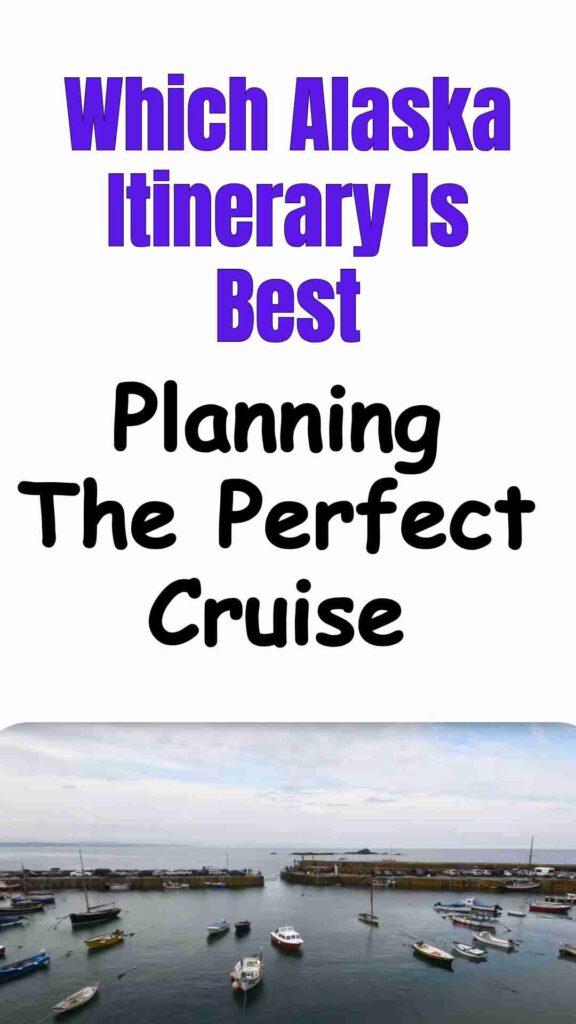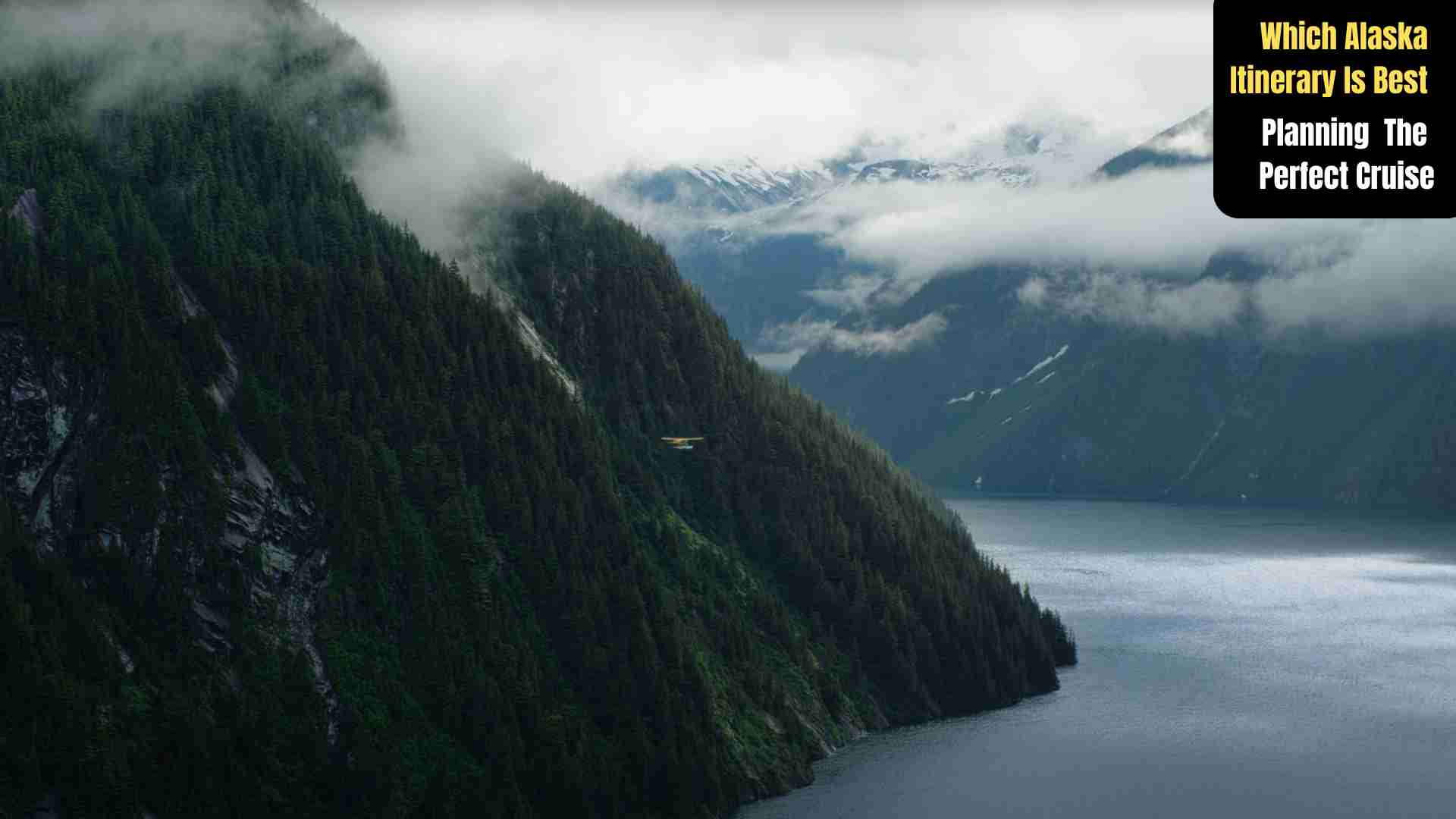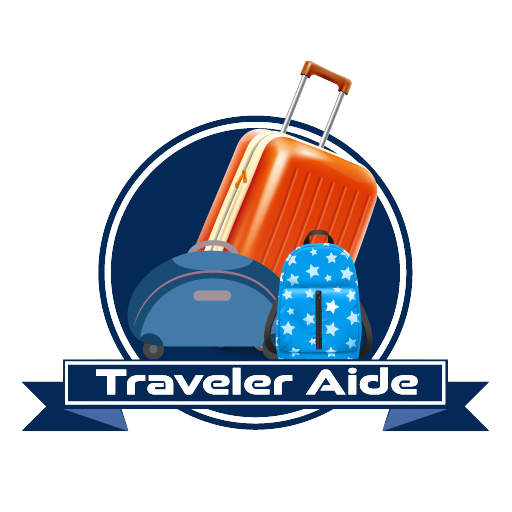There’s nothing quite like cruising through Alaska. The chill in the air, the humbling silence of glacier fields, the excitement of spotting a whale breach just off the deck—it’s magic. But if you’re staring at a long list of Alaska cruise itineraries wondering which Alaska itinerary is best, you’re not alone. Planning the perfect cruise isn’t just about picking a ship; it’s about choosing the route that fits you.
In this guide, I’ll walk you through the most popular routes, highlight key ports, help you weigh roundtrip vs. one-way cruises, and give honest tips on what to expect. Whether you’re chasing glaciers, wildlife, or cultural experiences, there’s an itinerary that fits your style—and budget.
Let’s start with the big decision: Inside Passage vs. Gulf of Alaska.
Inside Passage: Calm Waters, Coastal Charm
The Inside Passage is a classic route that weaves through Southeast Alaska’s coastal islands. If this is your first time cruising—or you’re prone to seasickness—this is probably your best bet. Protected waters mean smoother sailing, and you’ll still get jaw-dropping views of fjords, glaciers, and wildlife.
Typical Ports on the Inside Passage:
- Juneau – Alaska’s capital, only accessible by boat or plane. Don’t miss Mendenhall Glacier and whale watching tours.
- Skagway – Gold rush history meets wild mountain scenery. The White Pass & Yukon Route train is a must.
- Ketchikan – Totem poles, rainforest trails, and bald eagles. A great place for a floatplane tour or kayaking.
- Glacier Bay or Tracy Arm Fjord – Both are icy showstoppers, though not all cruises visit Glacier Bay due to limited permits.
This route is usually roundtrip from Seattle or Vancouver, making travel logistics easier. You can often find 7-day cruises, perfect for those short on time but big on adventure.
Gulf of Alaska (Northbound or Southbound): Deeper Alaska, More Variety
The Gulf of Alaska cruise digs deeper. You’ll sail between Seward or Whittier (near Anchorage) and Vancouver or Seattle, covering more ground and getting closer to the heart of Alaska’s interior. If you want to add a land tour—think Denali National Park or Fairbanks—this is the one to pick.

Highlights of Gulf of Alaska Itineraries:
- College Fjord or Hubbard Glacier – These northern glaciers are massive, dramatic, and less crowded than Glacier Bay.
- More time in port – Longer sailings or extended stops make it easier to take on bigger excursions.
- Open ocean – Expect a bit more motion on the water, especially when crossing the Gulf. It’s nothing extreme, but it’s worth knowing.
This option works well for travelers who want a cruise and land combo, or those flying into Anchorage and heading south—or vice versa.
Roundtrip vs. One-Way Cruises — What Fits You Best?
Once you’ve picked between the Inside Passage and Gulf of Alaska routes, it’s time to decide on how you want to cruise: roundtrip or one-way. Each has its pros and trade-offs, and the right choice depends on your travel style, time, and flexibility.
Roundtrip Cruises: Easy In, Easy Out
Roundtrip cruises are often the go-to for first-timers. These itineraries start and end in the same port—usually Seattle or Vancouver. That makes booking flights simple and often cheaper.
Pros of Roundtrip Cruises:
- Simpler travel logistics – No need to book multi-city flights or plan extra transfers.
- Shorter trips – Most are 7-day cruises, great for a weeklong getaway.
- More budget-friendly – Flights to Seattle or Vancouver are often cheaper than to Alaska, especially from the continental U.S.
Things to Consider:
- You’ll likely stick to Southeast Alaska, which is stunning, but you won’t venture as far north.
- Less opportunity to pair with land tours or inland adventures like Denali.
Roundtrip cruises are ideal if you want to dip your toes into Alaska without the complexity of one-way travel.
One-Way Cruises: More Adventure, More Depth
One-way cruises typically sail between Vancouver/Seattle and Seward or Whittier (just outside Anchorage). These trips go farther, often through the Gulf of Alaska, and give you access to more inland excursions.
Why Choose a One-Way Cruise:
- Deeper Alaska experience – You’ll cover more ground and see more diverse landscapes.
- Cruise-and-land packages – It’s easy to extend your trip with a train ride to Denali, or explore the Alaska Railroad.
- Unique glacier experiences – College Fjord, Hubbard Glacier, and other gems that roundtrip routes often skip.
Things to Consider:
- More complicated travel – You’ll need to fly into one city and out of another. Flights to or from Anchorage can also be pricier.
- Longer trip needed – To make the most of it, you’ll likely want at least 10–14 days for cruise + land.
If you’re ready to dive into Alaska’s heartland and don’t mind the extra planning, one-way cruises are well worth it.
Must-See Ports and What Makes Each One Special
Best Time to Cruise Alaska and How to Pick Your Cruise Line
No matter which Alaska itinerary you choose, your cruise will stop in some unforgettable places. Each port has its own vibe—some are charming and walkable, while others are launchpads for epic outdoor adventures. Here’s a breakdown of the most popular stops and what makes each one stand out.
Juneau: Glaciers, Whales, and Alaska’s Quirky Capital
It’s strange to think the capital of Alaska isn’t connected to any roads. You can only get to Juneau by air or sea. Once you arrive, though, it’s packed with choices.
Top experiences:
- Mendenhall Glacier – Just a short drive from town. Hike, kayak, or simply take in the view.
- Whale watching – Juneau is one of the best places to spot humpback whales, orcas, and sea lions.
- Mount Roberts Tramway – Ride to the top for panoramic views and scenic trails.
Juneau offers a great balance of accessibility and adventure. It’s a highlight for most travelers.
Skagway: Step Back into the Gold Rush Era
If you love history or trains, Skagway will be your kind of place. It feels like a movie set from the 1890s, and in many ways, it kind of is.
Don’t miss:
- White Pass & Yukon Route Railroad – A scenic train ride with dizzying mountain views.
- Historic downtown – Wander past old saloons, wooden boardwalks, and gold rush landmarks.
- Hiking trails – The Lower Dewey Lake Trail offers peaceful nature just minutes from town.
Skagway is small but rich in character—and a great spot for those who love stories from the past.
Ketchikan: Totem Poles and Misty Fjords
Known as the “Salmon Capital of the World,” Ketchikan offers a unique blend of native culture, rugged nature, and coastal charm.
Highlights include:
- Totem Heritage Center – Learn about Tlingit and Haida traditions and see centuries-old totem poles.
- Creek Street – A boardwalk district once known for its colorful history (and red-light past).
- Misty Fjords National Monument – Explore by floatplane or boat. Think towering cliffs and deep green waters.
Even on a rainy day (and there will be rainy days), Ketchikan is full of life.
Glacier Stops: The Real Showstoppers
Whether you’re cruising the Inside Passage or the Gulf of Alaska, glacier viewing is a big part of the draw. Not all itineraries hit the same ones, so it’s good to know the difference.
Common glacier highlights:
- Glacier Bay National Park – Accessible only to a limited number of ships per day. It’s pristine, massive, and feels almost spiritual.
- Tracy Arm Fjord – Steep, narrow, and full of floating icebergs. Perfect for photography lovers.
- Hubbard Glacier – One of Alaska’s biggest and most active tidewater glaciers. It’s loud, dramatic, and unforgettable.
- College Fjord – A quiet stretch with multiple glaciers, many named after East Coast colleges.
Your itinerary might include one or more of these, so if glacier viewing is your top priority, double-check the details when booking.
Best Time to Cruise Alaska and How to Pick Your Cruise Line
Timing matters more than you think when planning your Alaska cruise. From weather and wildlife to pricing and crowds, each month brings a slightly different experience. And once you’ve picked your dates, choosing the right cruise line is the next big step. Some focus on luxury, others on family fun, and a few are perfect for adventurous travelers.
When Is the Best Time to Cruise Alaska?
Alaska’s cruise season runs from late April through early October. Each month has its own strengths—and trade-offs.
May and Early June: Fewer Crowds, Fresh Snow
- Pros: Smaller crowds, lower prices, snow-capped mountains, blooming wildflowers.
- Cons: Some excursions (like dog sledding on snow) may still be limited due to late-season thaw.
- Wildlife: Bears are just coming out of hibernation; best chance to see them near rivers.
Mid-June to August: Peak Season
- Pros: Warmest weather, most daylight, everything is open and running full steam.
- Cons: Higher prices, more crowded ports, and ships may book out far in advance.
- Wildlife: Excellent chances to see whales, bears, eagles, and salmon runs.
September: Budget-Friendly and Autumn Vibes
- Pros: Better deals, fall colors, fewer crowds.
- Cons: Cooler temps, shorter days, higher chance of rain.
- Wildlife: Good chance of bear sightings as they hunt for salmon before winter.
If you’re cruising for scenery and calm weather, June and July are perfect. For fewer tourists and better deals, May or September might suit you better.
How to Choose the Right Cruise Line
Every cruise line offers something a little different. Some focus on comfort and culture, while others are built around entertainment or nature.
For First-Time Cruisers or Families:
- Princess Cruises and Holland America Line are Alaska pros. They’ve been doing this for decades and offer strong itineraries with great glacier viewing.
- Both lines are known for knowledgeable naturalists onboard and easy land tour extensions.
For Luxury Travelers:
- Regent Seven Seas, Silversea, and Viking offer upscale amenities, fewer passengers, and personalized service.
- These ships are smaller, which means they can access more remote ports and offer a more peaceful experience.
For Adventure Seekers:
- UnCruise Adventures or Alaskan Dream Cruises specialize in small-group trips with a focus on nature. Think kayaking near glaciers, hiking remote trails, and anchoring in quiet coves.
- These cruises aren’t about spa days or formal dinners—they’re immersive and raw in the best way.
For Budget-Conscious Travelers:
- Norwegian and Carnival tend to offer more affordable options, often sailing roundtrip from Seattle. You’ll get the essentials, with lively onboard entertainment and family-friendly vibes.
No matter which cruise line you choose, make sure to read the itinerary carefully. Some only offer glacier “cruising” days without actual stops, while others might skip certain key ports.
Final Tips, Mistakes to Avoid, and How to Make the Most of Your Alaska Cruise
Planning the perfect Alaska cruise isn’t just about picking the right route or ship. It’s also about what you do before and during the trip that can make or break the experience. To help you avoid the common pitfalls and make the most of every moment, here are some honest, practical tips—straight from real cruiser experiences.
What to Pack: Think Layers, Not Bulk
Weather in Alaska changes quickly—even in summer. You might start your day in the sun and end it in a downpour. So, what’s the best way to prepare?
Essentials to bring:
- A waterproof jacket (not just water-resistant)
- Layers: thermal shirts, fleece, and a packable down jacket
- Comfortable walking shoes with good grip
- Lightweight hat and gloves (yes, even in July!)
- Binoculars for wildlife viewing from the deck
- Motion sickness remedies if you’re sailing the Gulf
Forget the formalwear-heavy mindset some cruises push. In Alaska, function wins over fashion.
Mistakes to Avoid
Even seasoned travelers slip up when it comes to Alaska cruises. Here are some of the most common mistakes—and how to sidestep them:
1. Not booking excursions in advance
Popular excursions like whale watching, dog sledding, and flightseeing tours sell out fast, especially in peak season. Book early to avoid disappointment.
2. Thinking “glacier day” means getting off the ship
In most itineraries, glacier viewing happens from the ship—you don’t disembark. Plan to be up early, camera ready, and dress warm. It’s often the highlight of the whole cruise.
3. Choosing the wrong side of the ship
For one-way cruises, port side (left) is often better going northbound, and starboard (right) is better southbound for coastline views. It’s not a dealbreaker, but good to know.
4. Underestimating how remote some ports are
Wi-Fi is spotty. Cell coverage disappears. And that’s part of the magic. Just make sure you download any important travel info beforehand.
Bonus Tips: Making the Most of Your Cruise
- Wake up early – Wildlife is more active, and the morning light over the mountains is unreal.
- Talk to the naturalists – Most cruises have onboard experts who give talks and point out wildlife. They often share tips that aren’t in the brochures.
- Spend time on deck – You don’t need a balcony to enjoy the views. The open decks are often less crowded and give you a 360° experience.
- Try local food – Whether on board or at port, go for the salmon, crab legs, or halibut tacos. Alaska’s seafood is top-notch.
- Keep your expectations flexible – Weather can change plans. Ships may skip a glacier or shorten a port stop. But the moments you do get will be worth it.
So, Which Alaska Itinerary Is Best?
Here’s the honest truth: there’s no single “perfect” Alaska cruise—it depends on what you value most.
- Want the classic intro to Alaska? Inside Passage, roundtrip from Seattle or Vancouver is easy and beautiful.
- Craving big glaciers and deeper exploration? One-way Gulf of Alaska itineraries offer more variety and access to inland adventures.
- Have more time and love the wild? Consider adding a land tour to see Denali, take the Alaska Railroad, or even visit the Arctic Circle.
Whichever route you choose, cruising Alaska is the kind of trip that leaves a mark. It humbles you, stuns you, and makes you want to come back for more. And with a little planning, you’ll be ready to experience it all—glaciers, whales, misty fjords, and memories that last a lifetime.


